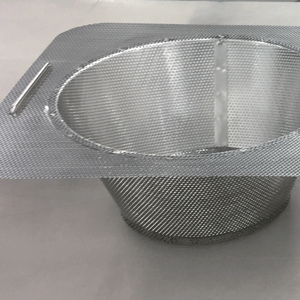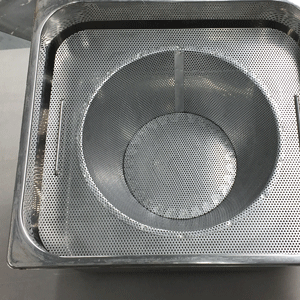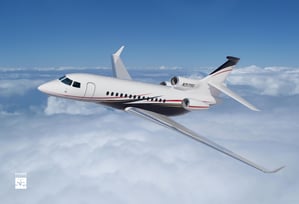 No detail, no matter how small, escapes the notice of Duncan Aviation team members. Earlier this year, a long-time customer from Jakarta, Indonesia, arrived with his company’s Challenger 604. To the casual observer, a custom-designed sink strainer is no big deal, but it was critical to Senior Financial Advisor for Air Pacific, Muliawan Sutanto, and the rest of the flight crew.
No detail, no matter how small, escapes the notice of Duncan Aviation team members. Earlier this year, a long-time customer from Jakarta, Indonesia, arrived with his company’s Challenger 604. To the casual observer, a custom-designed sink strainer is no big deal, but it was critical to Senior Financial Advisor for Air Pacific, Muliawan Sutanto, and the rest of the flight crew.
Muliawan explained that they eat a lot of meals with rice, and despite how carefully the attendant rinsed the dishes, tiny grains of rice still slipped down the drain, and the resulting clogs were costly in terms of time and money.
A clogged drain renders the sink unusable, and clearing the drain requires that the company put down the aircraft. As nearly everyone in aviation knows, putting down an business aircraft for unscheduled maintenance is costly in terms of lost flying time, and unclogging a drain is surprisingly expensive.
“Aircraft sinks have small strainers that cover only the drain, and they get blocked pretty quickly,” says Duncan Aviation Cabinet Shop Team Leader Matt Beaudette. “When those little strainers are blocked, the sink backs up so water won’t drain, but when you lift out the strainer to clean it off, all of those little food particles go down the drain, which eventually clogs it.”


Matt researched larger strainers and realized a strainer that fits inside the sink would trap the small grains of rice while still allowing water to drain. The problem was strainers that fit inside aircraft sinks don’t exist, so he mentioned to problem to Fabrication Shop Team Leader Bryan Hart.
Bryan came up with a workable design, and he and his team crafted a custom strainer to fit inside the Challenger’s sink.
“We’re thrilled with the strainer, and it’ll more than pay for itself by preventing even one clogged drain,” says Muliawan. “It fits inside the sink, traps the food particles, and lifts out easily so the attendant can clean it.”
The Fall Duncan Debrief is now online. Download your copy now.




2.jpg?width=603&height=122&name=Global%209085%20LH%20Elevation%2001.136%20(edits)2.jpg)
3.jpg?width=206&name=FWD%20To%20AFT%20Cabin%20View%2001(Drinkrail%20Switches)3.jpg) “When clients look at the illustration, they might say, ‘Whoa! The darker material is too heavy for that space. Let’s go with the lighter color.’ Or, if they really want that dark color, we can suggest other options, such as going with a lighter color on the leather seats or carpet to provide more of a contrast and get the ratio of light to dark correct,” says Dan. “It’s far better to find out on the front end before any work has been done on a project. Our clients especially appreciate being able to see exactly what they’re getting.”
“When clients look at the illustration, they might say, ‘Whoa! The darker material is too heavy for that space. Let’s go with the lighter color.’ Or, if they really want that dark color, we can suggest other options, such as going with a lighter color on the leather seats or carpet to provide more of a contrast and get the ratio of light to dark correct,” says Dan. “It’s far better to find out on the front end before any work has been done on a project. Our clients especially appreciate being able to see exactly what they’re getting.”

.jpg?width=275&name=IMG_8278%20(Mobile).jpg)
 Instead, with unique designs from Duncan Aviation’s Battle Creek Multi Media Illustrator Ken Reita, the owner decided to go with a complete interior refurbishment.
Instead, with unique designs from Duncan Aviation’s Battle Creek Multi Media Illustrator Ken Reita, the owner decided to go with a complete interior refurbishment.
.jpg?width=603&height=339&name=GVSP-N755VE-020%20(Medium).jpg) “Because of the reliability of Gulfstream aircraft, they continue to be dependable business tools, regardless of age,” says Completions/Modification Sales Manager Nate Klenke. “This serial number was a top performer in our client’s fleet, so they decided to give it a facelift and keep it flying.”
“Because of the reliability of Gulfstream aircraft, they continue to be dependable business tools, regardless of age,” says Completions/Modification Sales Manager Nate Klenke. “This serial number was a top performer in our client’s fleet, so they decided to give it a facelift and keep it flying.”.jpg?width=345&name=GVSP-N755VE-033%20(Medium).jpg)
 Duncan Aviation Lead Designer Rachael Weverka redesigned the interior for the Gulfstream, proposing an updated color scheme, all new soft goods (fabrics, seat upholstery, headliner fabrics) in the cabin and a unique combination of natural veneers and colored accents.
Duncan Aviation Lead Designer Rachael Weverka redesigned the interior for the Gulfstream, proposing an updated color scheme, all new soft goods (fabrics, seat upholstery, headliner fabrics) in the cabin and a unique combination of natural veneers and colored accents.-1.jpg?width=603&height=402&name=GVSP-N755VE-037%20(Small)-1.jpg) “Now, owners want their interiors to reflect their personalities,” says Rachael. “The custom designs involve colors, fabrics, and textures we haven’t often used in aircraft interiors. It’s been fun to be part of this shift.”
“Now, owners want their interiors to reflect their personalities,” says Rachael. “The custom designs involve colors, fabrics, and textures we haven’t often used in aircraft interiors. It’s been fun to be part of this shift.”.jpg?width=260&name=Bill%20Walker_0I9A0482DuncanFinal%20(Small).jpg) Lyn and Bill have been friends for years. Before coming to work at Duncan Aviation in 2004, Bill was an engine mechanic for a company near his home in Granite City, Illinois, where Lyn took his Challenger for maintenance. After moving to Duncan Aviation as an Engine Tech Rep, Lyn and Bill have maintained contact and their professional friendship. Lyn considers Bill a CF34 guru, and Bill continues to do the engine work for the Challenger 850 SE.
Lyn and Bill have been friends for years. Before coming to work at Duncan Aviation in 2004, Bill was an engine mechanic for a company near his home in Granite City, Illinois, where Lyn took his Challenger for maintenance. After moving to Duncan Aviation as an Engine Tech Rep, Lyn and Bill have maintained contact and their professional friendship. Lyn considers Bill a CF34 guru, and Bill continues to do the engine work for the Challenger 850 SE..jpg?width=273&name=IMG_8278%20(Mobile).jpg) Duncan Aviation has a network of 26 Satellite Avionics Shops and work-away stations located at the busiest airports in the United States. Each shop has knowledgeable, experienced avionics technicians who have already brought dozens of aircraft into compliance with the ADS-B mandate.
Duncan Aviation has a network of 26 Satellite Avionics Shops and work-away stations located at the busiest airports in the United States. Each shop has knowledgeable, experienced avionics technicians who have already brought dozens of aircraft into compliance with the ADS-B mandate.
.jpg?width=258&name=IMG_0074L_Final%20(Small).jpg) Scott Fitzgerald, the owner’s representative, called Duncan Aviation’s Completions and Modifications Sales Rep Adam Bruce, and they had a month of conversations that resulted in a quote for a new paint job and partial interior completions.
Scott Fitzgerald, the owner’s representative, called Duncan Aviation’s Completions and Modifications Sales Rep Adam Bruce, and they had a month of conversations that resulted in a quote for a new paint job and partial interior completions.